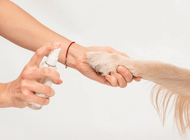Paw Sanitizer for Cats and Dogs
Pets often walk around areas with high concentrations of microbes (e.g., bacteria, viruses, fungi) that put them at risk of several ailments and infections.
Based on research, paws are especially loaded in different strains of bacteria that could be dangerous for the health of your pet, as well as yours.
Fortunately, paw sanitizers serve as great tools that kill harmful microbes to keep your pet free of infections.
In this article, we will discuss the benefits of paw sanitizers and how they could reduce the risk of serious disease.
The germs found on your pet’s paws
According to North Carolina University, researchers identified the presence of bacteria in households with dogs relative to pet-free households.
Unsurprisingly, households with pets had a higher number and diversity of bacteria, which is explained by the outdoor behavior of pets.
The identified bacteria included Escherichia coli, salmonella, listeria, and methicillin-resistant Staphylococcus aureus (MRSA). These bacteria can cause severe infections in humans, such as pneumonia, meningitis, and digestive infections.
MRSA alone can lead to debilitating infections that resist conventional antibiotics, which can be deadly in some cases. In fact, patients with MRSA-related infections are at a higher risk of death compared to any other type of infection.
When your pet walks around outside, it is inevitable that they bring many microbes home. This occurs when they walk inside the house, sit on the couch, and touch the children with their paws. Unfortunately, this could precipitate serious infections.
How paw sanitizers help
Paw sanitizers are typically composed of environmentally-friendly ingredients (no toxins or alcohol) that eradicate bacteria on your dog and reduce the risk of inflammation-linked conditions, such as allergies and pruritus (i.e., itching).
The formula is pure, safe, and causes no side effects if ingested (pets commonly lick their paws).
The primary ingredient is typically benzalkonium chloride, which is commonly used to sanitize foods and drinks.
The best time to use pet sanitizers is after coming from a walk, which inadvertently leads to the accumulation of germs on your pet’s paws. The sanitizer will also help remove any bad smelling odors.
If you notice that your pet is acting weird after using paw sanitizer, you may want to get them checked out by a certified veterinarian to exclude any allergic reactions to the formulating ingredients.
Takeaway message
Paw sanitizer is a fantastic tool to remove all the germs from your pet’s paws, which is the region where most of the germs pile up.
Hopefully, this article managed to introduce the importance of paw sanitizers and how they could prevent serious infections in your pet and yourself.
If you still have any questions about this topic, please do not hesitate to share your thoughts in the comment section below.
 CAD
CAD




